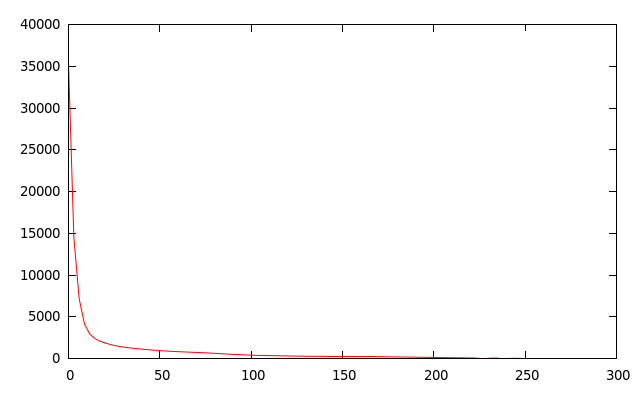- From: Roberto Peon <grmocg@gmail.com>
- Date: Thu, 15 Aug 2013 14:06:45 -0700
- To: Martin Thomson <martin.thomson@gmail.com>
- Cc: HTTP Working Group <ietf-http-wg@w3.org>
- Message-ID: <CAP+FsNe0f6faER6ntExrFk4uAG-tNG9sao61upH-NjA-5tds7A@mail.gmail.com>
I did this testing a while back (look for email entitled "Compression analysis of perfect atom-based compressor"). Someone can hack something up to do this again on the new corpus, but the data was pretty unequivocal. I've attached a PNG version of the freq vs dist-from-newest-element graph. Again, this was with a "perfect" FIFO-based compressor, which had no expiry and infinite space over the test corpus (with each domain having a separate compressor, but summing into the final total) that was available to us before the new larger, if munged, corpus that was recently contributed. This is a graph of the number of times that you'd like to have backreferenced something (y-axis) at the distance from the newest element (x-axis). If we always found that we wished to backreference the 10th most recent item (which is most certainly not the case, but IF), then this graph would be a single spike at 10. And here is the data. [image: Inline image 1] I'd welcome someone computing this again! -=R On Thu, Aug 15, 2013 at 1:30 PM, Martin Thomson <martin.thomson@gmail.com>wrote: > On 15 August 2013 13:00, Roberto Peon <grmocg@gmail.com> wrote: > > Currently, index 0 is the 'top' of the table, and when a new header is > added > > using incremental indexing, it is added at the 'bottom' (i.e. the highest > > number index). > > There are two separate issues here. Strangely, the right decision > depends on the same question. See below. > > The first is whether the most recently added values should appear at > index 0 or index n when adding to the table. This wouldn't matter at > all if it weren't for the fact that small values take less space to > encode. So, any decision we make should be based on what we believe > is going to be reused more often: things that are added recently, or > things that have been present for a long time. If it's recent items > that are being used more often, we probably need to add at index 0. > > The second relates to eviction: which items be evicted from the header > table? Those that were most recently added, or those that have been > around for a long time? As I hinted before, this depends on the same > question. > > Intuitively at least, I believe that there will be a split on the > header reuse question. Some things, like :method=GET, are probably > going to be quite stable. Other things, like cookies, tend to change > such that old values are invalid (Cookie in particular might be a good > candidate for substitution). If there is a split, then I can imagine > that some optimizations could give good returns... maybe something > analogous to a generational garbage collector. But then, I can't > imagine a way to avoid the resulting performance and complexity > issues. > > But that's just analysis. Testing might be an easier way to decide, > or at least to inform the choice. >
Attachments
- image/png attachment: freq_vs_dist_from_newest_element.png

Received on Thursday, 15 August 2013 21:07:15 UTC